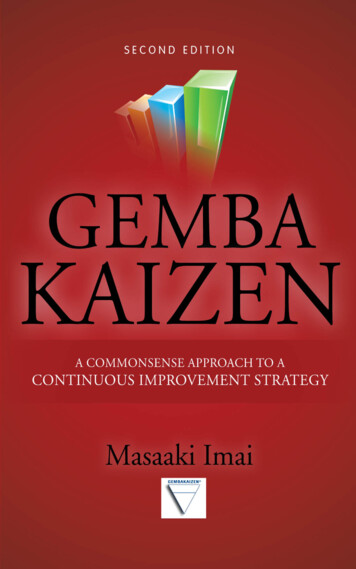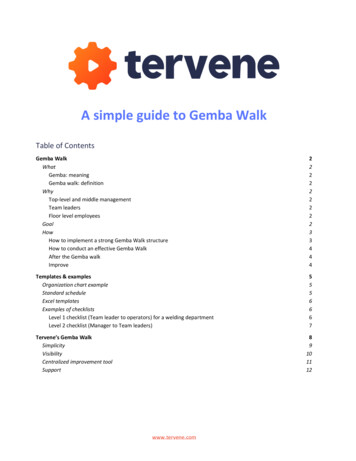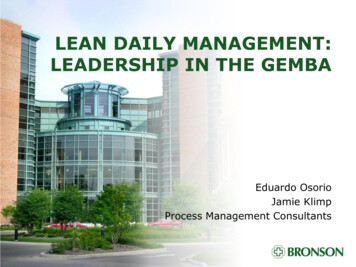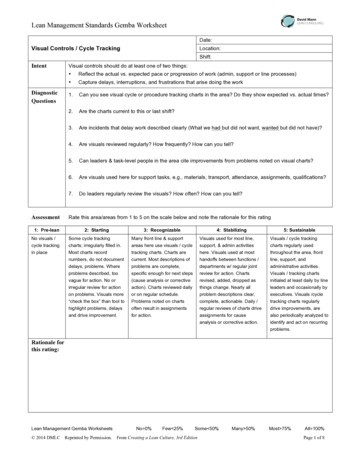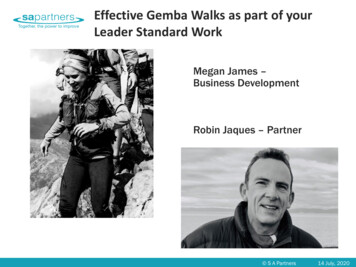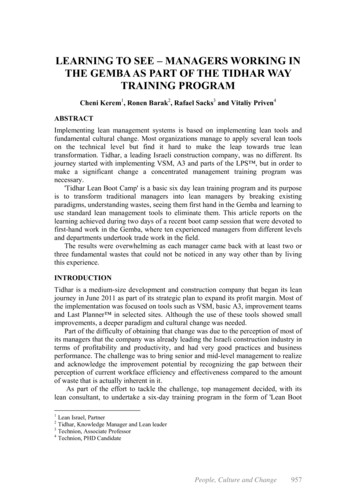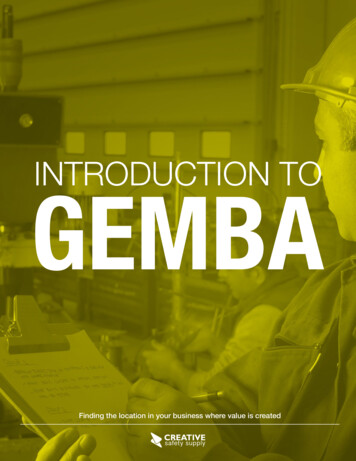
Transcription
INTRODUCTION TOGEMBAFinding the location in your business where value is created
CHAPTERS1. What is Gemba? . . . . . . . . . 42. The Gemba Walk . . . . . . . . . 53. What Gemba is and What itis Not . . . . . . . . . . . . . . . 6Hundreds of InnovativeProducts and Solutions4. 4 Steps to Realizing GembaSuccess . . . . . . . . . . . . . . 7Knowledgeable Staff5. Example Gemba WalkSchedule . . . . . . . . . . . . 126. Gemba Reveals Waste . . . . . 13Free, Fast Shipping onOrders to US & Canada*some restrictions apply, see websiteFree Guides, Podcasts,Infographics, Blogs andmuch more7. Lean Manufacturing . . . . . . 148. The 3 M’s: Muda, Mura, Muri . 179. Kaizen . . . . . . . . . . . . . . 1910. Summary . . . . . . . . . . . . 2011. Additional Resources . . . . . 21Creative Safety Supply is a globalsupplier of Safety and Lean productsand manufacturer of leading brandssuch as LabelTac Label & Sign Printersand SafetyTac Industrial Floor Tapes.Additionally, Creative Safety Supply offersa wide selection of floor signs, wall signsand other high visibility signage solutions.CSS also bridges the gap betweenproducts and knowledge, offering a rangeof free resources for safety professionalsor employees looking to learn moreabout Safety, Lean Manufacturing, GHS,Continuous Improvement and other topics.creativesafetysupply.comor call us at 1-866-777-1360Introduction to Gemba creativesafetysupply.com
LEGAL DISCLAIMERAll contents copyright 2015 by Creative Safety Supply. All rights reserved. No part of this document oraccompanying files may be reproduced or transmitted in any form, electronic or otherwise, by any meanswithout the prior written permission of the publisher.This ebook is presented to you for informational purposes only and is not a substitution for any professionaladvice. The contents herein are based on the views and opinions of the author and all associatedcontributors.While every effort has been made by the author and all associated contributors to present accurate and upto-date information within this document, it is apparent technologies rapidly change. Therefore, the authorand all associated contributors reserve the right to update the contents and information provided herein asthese changes progress. The author and/or all associated contributors take no responsibility for any errorsor omissions if such discrepancies exist within this document.The author and all other contributors accept no responsibility for any consequential actions taken, whethermonetary, legal, or otherwise, by any and all readers of the materials provided. It is the readers soleresponsibility to seek professional advice before taking any action on their part.Readers’ results will vary based on their skill level and individual perception of the contents herein, and thusno guarantees, monetarily or otherwise, can be made accurately. Therefore, no guarantees are made.Introduction to Gemba creativesafetysupply.com
What Is Gemba?Gemba, a term first used by Toyota, meansgoing to the real place where the action is. Inthe 1980s, ‘In Search of Excellence’ authorTom Peters popularized the concept whenhe talked about management by wanderingaround (MBWA).Like MBWA, gemba walks take managementto the front lines to see daily happenings.Gemba, however, is more focused.Find Where Value IsCreatedGemba refers to “the real place,” the locationwhere value is created in your business. Inan industrial environment, that place is oftenthe manufacturing floor where you create theproducts you sell to your customers.By going to that place and observing workprocesses, managers can gain new data anda fresh perspective.In lean thinking, a gemba walk allowsmanagers to identify areas of waste thatcould be eliminated from work processesto improve efficiency. In reality, though, agemba walk can reduce waste, improvecompany culture, and even increase safety inthe workplace.Take a Break FromTechnologyWhy? Because managers spend too muchtime at their desks reading reports, gazingat smartphones, attending back-to-backmeetings, and relying on their inner circle tosupply them with information.Think of getting up and walking around as anopportunity for discovery — an eye-opener.In this guide, we’ll examine how to plan forand begin taking successful gemba walks inyour workplace so you can better solve yourcustomers’ problems and your workplace’sissues.Why Is Gemba Importantfor Businesses?Organizations are VERTICAL and oftencomplex, with managers looking up towardthe top (the CEO) for direction. Employeesturn to management for direction.Value flows HORIZONTALLY acrossorganizations to customers. A gemba walkhelps managers see and reconcile thehorizontal with the vertical.Introduction to Gemba creativesafetysupply.com4
The Gemba WalkThe Objective of a GembaWalkIn businesses, managers often look tocompany leaders for direction. The valuecreated by a business, though, exists outon the work floor. By taking gemba walks,managers can get ideas for improvementfrom the place where value is actuallycreated.The objective of a gemba walk is not to mapout your facility and note every area thatneeds improvement all at once. It’s alsonot to look for errors and correct them rightaway.Rather, the purpose of the gemba walkis to go out and see what’s actuallyhappening, begin a dialogue with workers,and then return from the walk with ideas forimprovement.Your goal is also to assess your processesfrom start to finish, measuring the work yousee to determine how successful it is. Thiscan be done over a series of walks ratherthan all at once, too, allowing you to focus onspecific parts of your value-creation process.The Approach to aGemba WalkTherefore, you should approach your workerswith respect and interest in what they do.You should not plan to remedy problemsor correct behaviors while you’re out onthe work floor. Prepare to observe, askquestions, and promote creative thinkingamong employees.You should also try to approach your walkwithout assumptions about what you will find.This can be difficult to do, but assuming youalready know what the situation is before yousee it can prevent you from observing realityclearly.Developing New GembaSkillsSuccessful observation requires practice.Over time, managers who take gemba walkslearn how to look at their business’ processesin productive ways. They learn whatcircumstances indicate problems are present,they learn what questions to ask workers,and they learn to use their observations toimplement improvements.Beginning gemba walk practitioners shouldremember that observation takes time, effort,and patience. You may not feel comfortablewith the process right away, but over timeyou will gain confidence.The secret to gemba walks is the fine linebetween engagement and snooping. If you’re“managing by wandering around” to checkup on people and make sure they are reallyworking, you’re going to breed discontent.But if you’re genuinely interested in whatpeople are working on, they will look forwardto seeing you.Introduction to Gemba creativesafetysupply.com“Farming looks mightyeasy when your plowis a pencil and you’re1,000 miles away from acornfield.”--Dwight Eisenhower5
What Gemba Isand What It Is NotGemba IS NOT.Management by walking around (MBWA). MBWA is often too unstructured tobe of value. It can be ineffective and hurt morale.Gemba DOES NOT.Solve specific problems by walking around pointing out negatives, orapproach processes with proconceived notions about their inadequaciesGemba IS. Where the activity is performed A great opportunity to strengthen your team cultureGemba DOES.Observe with a deep interest and seek to gain understanding while leaving allassumptions and opinions at the officeIntroduction to Gemba creativesafetysupply.com6
4 Steps toRealizing GembaSuccess:1. Know the PurposeBefore you head out on your gemba walk,you need to plan. Tackling an entire valuecreation process at once is overwhelmingand often results in vague observations thataren’t very useful.To create a plan, you first need to understandyour purpose on both a large and smallscale. In the most general sense, what isthe purpose of your business? Presumably,your purpose is to help your customer solvea problem in some way. The product youprovide solves that problem. Make sureyou always keep that purpose in mind. Forexample, during your walk you might askyourself how a particular step in a processadds value for a customer.More specifically, you need to have a purposefor your gemba walk, and it’s often useful tohave a purpose more specific than “assessthe state of my company’s processes.”Decide what aspect of your operations youwant to look at during a given walk andkeep in mind what you want to learn. Maybeyou want to look at how safe a process isor whether any extra motion exists duringa task. Understand that you can’t covereverything at once. Do stay open-mindedduring your walk, though, to whatever yousee.1. Know thePurpose2. Know theGemba3. Observe4. ImproveAdditionally, remember that an importantaspect of any gemba walk is creating adialogue with people and encouraging themto think creatively about work tasks androadblocks.Introduction to Gemba creativesafetysupply.com7
2. Know the GembaTo observe and assess anything, you needto understand it. So before you head outon your gemba walk, you need to haveknowledge of the processes and people inyour facility.Consider what the core activities of yourbusiness are and where they’re located.You might want to take visits to yourmanufacturing floor, the place whereproducts are developed, the shippingdepartment, the people in charge ofmanaging suppliers, or even your customerservice team. You shouldn’t try to visit allof those locations at once, but they’re likelyall important to the products you create.Determine which ones you plan to visit duringa walk. Consider making a schedule forgemba walks if that helps you.Each organization has different places wherevalue is created, so your business may havemany more gembas that you should visit.Whatever the location, know what standardprocedures are so when you observe themyou can consider how well they are workingand whether they should be adjusted.Remember, though, that you should think ofyour workplace as a team. Calling something“your” gemba can limit your thinking andrestrict teamwork.Introduction to Gemba creativesafetysupply.com1. Know thePurpose2. Know theGemba3. Observe4. Improve8
3. ObserveOnce you understand the goals and activitiesthat go on in your workplace, it’s time to putyour new knowledge of gemba into practiceand observe. Remember to approach yourwork without bias and be open-minded.Your attitude will have a large impact on thesuccess of your walk.1. Know thePurposeDuring your walk, focus on aspects ofyour process that are currently of interest.You might examine efficiency, safety, orhousekeeping. You might even take a look atyour waste pile as a way to see what kinds ofdefects exist.2. Know theGembaAs you walk, think about the purpose, thepeople, and the process. These three ideasare all connected. The purpose of solving acustomer’s problem is achieved by peopleand the process. When you see a problem,you can ask how and why something is done,but don’t blame or try to correct employees.While at the gemba, focus on taking ininformation and fostering a discussion.3. Observe4. ImproveIntroduction to Gemba creativesafetysupply.com9
3. Observe (Continued)Questions to Consider During aGemba WalkEach gemba walk will be different, but thesegeneral questions can help you focus on yourpurpose, people, and process: Do problems ever pop up for you? What would you change about this if youcould? What tools do you use? What is working well? Is protocol being followed? Which activities add value? What stations or individuals create value? Are expected levels of output being met? Are there variations in the process? Are there abnormalities in products?Don’t hide behind technology. Instead, useit to help see, hear, and feel. The rise ofinexpensive electronic equipment can aidgemba walks. A manager can go througha plant, office, or warehouse and recordinformation for review later. Is cleanliness a problem?Tools to try: Is machinery in good working order? Do workers need training or support?Tablets or mobile devices for notetakingor audio/video recording Is any documentation needed? Cameras/video cameras Are tasks done safely? Is there any wasted time or resources?GPS tracking systems to trackequipment, supplies, or other movingassets (This can be used to investigateissues found during a walk.)Tools to Take on Your GembaWalkQuestions to Ask WorkersFirst and foremost, you want to observeworkers. It’s usually better if they don’t knowa gemba walk will be happening so theybehave normally. That being said, you dowant to engage them in a dialogue. If youneed help starting a conversation with yourworkers after observing them, here are somequestions that can help: Can you show me how you perform thistask? Is it always done this way?Introduction to Gemba creativesafetysupply.com“There was a perceptionthat I was going out tocatch people. Over timethey understand that Ijust want to see it likea customer. I can domy job better if I havefirsthand exposure to thegood, the bad and theugly.”--Bob Nardelli – CEOHome Depot10
4. ImproveAfter your walk, reflect on what you’veobserved. Perhaps you saw employeesspending a lot of time walking back and forthto get tools, and some workers suggestedrearranging a workstation to reduce thiswasted time. Now you can come up with aplan to make the needed changes, determinewho will implement them, and followthrough to see the adjustments are made.Even better, you can follow up again on afuture gemba walk after the changes haveoccurred to observe whether the process hasimproved.Whatever you observed and discussed withworkers, c
Introduction to Gemba creativesafetysupply.com 5 The Gemba Walk The Objective of a Gemba Walk In businesses, managers often look to company leaders for direction. The value created by a business, though, exists out on the work floor. By taking gemba walks, managers can get ideas for improvement from the place where value is actually created.
